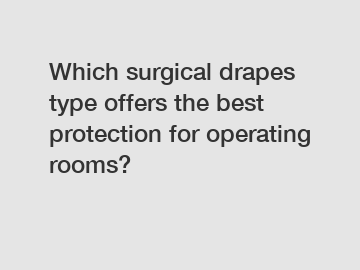Which surgical drapes type offers the best protection for operating rooms?
Which surgical drapes type offers the best protection for operating rooms? This critical question has been a subject of speculation and discussion among medical professionals for years. In this article, we will explore the various types of surgical drapes and analyze the factors that determine their effectiveness in protecting operating room environments. By delving into the rationale and impact of each drape type, we aim to provide a comprehensive understanding of the best practices in surgical draping.
I. Understanding the Different Surgical Drapes:
Operating rooms require a sterile environment to minimize the risk of surgical site infections and cross-contamination. Dedicated surgical drapes play a crucial role in achieving this goal. There are primarily four types of surgical drapes commonly used:

1. Disposable Polyethylene Drapes: These drapes offer a reliable barrier against fluid penetration and provide a cost-effective solution. However, they have limited breathability and may be prone to tearing.
2. Reusable Cloth Drapes: Made from tightly woven fabrics, these drapes are durable and resistant to fluid penetration. They can be laundered and sterilized for multiple uses, reducing waste. Nevertheless, the laundering process may add to the financial burden and time required for maintenance.
3. Impervious Film Drapes: Constructed from plastic polymers, these drapes create a complete barrier against fluid and bacterial penetration. They are particularly effective when it comes to preventing potential contamination. However, the non-breathable nature of these drapes can lead to increased heat and discomfort for the surgical team.
4. Antimicrobial Drapes: Designed to inhibit the growth of bacteria, these drapes provide an added layer of protection. They combine the benefits of impervious film drapes while minimizing the risk of surgical site infections. However, antimicrobial drapes may come at a higher cost compared to other options.
II. Determining the Best Protection:
The decision regarding the most suitable surgical drape type ultimately depends on several critical factors:
1. Procedure Type: The nature of the surgical procedure plays a vital role in selecting the appropriate drape. For high-fluid procedures, impervious film drapes or disposable polyethylene drapes may offer better protection. Alternatively, reusable cloth drapes or antimicrobial drapes could be preferred for more general procedures.
2. Material Properties: Evaluating the breathability, strength, and liquid resistance of different drape materials is crucial. The chosen drape type should strike a balance between impermeability and comfort for the surgical team.
III. Significance and Impact:
The selection of the most suitable surgical drape directly affects patient outcomes, healthcare costs, and the overall efficiency of operating room practices. By using the right drape type, healthcare facilities can mitigate the risk of post-operative infections and improve patient safety. Furthermore, a judicious choice of drapes can lead to reduced waste generation, enhanced comfort for medical professionals, and optimized resource allocation.
In conclusion, the optimal choice of surgical drapes for operating room protection depends on the specific procedure and material properties. Understanding the strengths and limitations of different drape types allows medical professionals to make informed decisions, with patient safety and cost-effectiveness as key considerations. By prioritizing the selection process, healthcare facilities can create a safer and more efficient environment for surgical interventions.
If you are looking for more details, kindly visit Disposable Surgical Gown Manufacturer, c-section pack, SMS Lamination manufacturer.

Comments
0